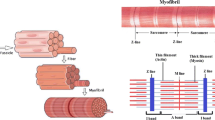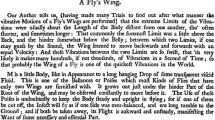Summary
The crossbridge mechanism leading to oscillation in insect flight muscle is studied theoretically based on a three-state model proposed by Nishiyamaet al. [Biochim. biophys. Acta 460, 523–36 (1977)]. Skeletal muscle as well as insect flight muscle shows oscillatory contraction. We demonstrate this oscillatory contraction in muscle by choosing proper rate constants among the three states of the model. It is established that our model gives out not only Hill's force-velocity relation but also other mechanical properties of skeletal muscle. The model is then compared with two types of experiment by Kawai & Brandt [J. Musc. Res. Cell Motility 1, 279–303 (1980)] and by Steiger & Rüegg [Pflügers Arch. 307, 1–21 (1969)]. Kawai & Brandt obtained the Nyquist plot showing the relation between the phase shift and the amplitude of tension change in response to sinusoidal length changes at various frequencies. Steiger & Rüegg studied the power output and ATPase activity at various frequencies of the length change. Our theoretical results are in good agreement with the results of these two experiments. To determine the crossbridge mechanism which produces the positive power output, spatio-temporal crossbridge distributions in the three states are calculated. It is shown that, after the stretching phase of sinusoidal change in muscle length, the delayed rise of tension is caused by attachment of crossbridges to the active state via the preactive state while the delayed fall is caused by detachment from the active state after release. To obtain the oscillatory property it is not necessary to assume that stretch in muscle length increases the attaching rate as originally proposed by Thorson & White [Biophys. J. 9, 360–90 (1969)].
Similar content being viewed by others
References
Abbott, R. H. (1973) An interpretation of the effects of fiber length and calcium on the mechanical properties of insect flight muscle.Cold Spring Harbor Symp. quant. Biol. 37, 647–54.
Abbott, R. H. &Steiger, G. J. (1977) Temperature and amplitude dependence of tension transients in glycerinated skeletal and insect fibrillar muscle.J. Physiol., Lond. 266, 13–42.
Brokaw, C. J. (1975) Molecular mechanism for oscillation in flagella and muscle.Proc. natn. Acad. Sci. U.S.A. 72, 3102–6.
Brokaw, C. J. (1976) Computer simulation of flagellar movement. IV. Properties of an oscillatory two-state cross-bridge model.Biophys. J. 16, 1029–41.
Cheung, A. S. &Gray, B. F. (1983) Muscle tension response to sinusoidal length perturbation: a theoretical study.J. Musc. Res. Cell Motility 4, 615–23.
Ford, L. E., Huxley, A. F. &Simmons, R. M. (1974) Mechanism of early tension recovery after a quick release in tetanized muscle fibres.J. Physiol., Lond. 240, 42–3P.
Goodall, M. C. (1956) Auto-oscillations in extracted muscle fibre systems.Nature, Lond. 177, 1238–9.
Gray, B. F. &Gonda, I. (1977a) The sliding filament model of muscle contraction. I. Quantum mechanical formalism.J. theoret. Biol. 69, 167–85.
Gray, B. F. &Gonda, I. (1977b) The sliding filament model of muscle contraction. II. The energetic and dynamical predictions of a quantum mechanical transducer model.J. theoret. Biol. 69, 187–230.
Güth, K., Kuhn, H. J., Brexler, B., Berberich, W. &Rüegg, J. C. (1979) Stiffness and tension during and after sudden length changes of glycerinated single insect fibrillar muscle fibres.Biophys. Struct. Mechanism. 5, 255–76.
Herzig, J. w. (1977) A model of stretch activation based on stiffness measurements in glycerol extracted insect fibrillar flight muscle. InInsect Flight Muscle (edited byTregear, R. T.), pp. 209–19. Amsterdam: North Holland.
Hill, T. L. (1974) Theoretical formalism for the sliding filament model of contraction of striated muscle.Progr. Biophys. molec. Biol. 28, 267–340.
Hill, T. L., Eisenberg, E., Chen, Y. &Podolsky, R. J. (1975) Some self-consistent two-state sliding filament models of muscle contraction.Biophys. J. 15, 335–72.
Huxley, A. F. &Simmons, R. M. (1971) Proposed mechanism of force generation in striated muscle.Nature, Lond. 233, 533–8.
Huxley, A. F. (1974) Muscular contraction.J. Physiol., Lond. 243, 1–43.
Jewell, B. R. &Rüegg, J. C. (1966) Oscillatory contraction of insect fibrillar muscle after glycerol extraction.Proc. R. Soc. Ser. B. 164, 428–59.
Julian, F. J., Sollins, K. R. &Sollins, M. R. (1974) A model for the transient and steady-state mechanical behavior of contracting muscle.Biophys. J. 14, 546–62.
Kawai, M. &Brandt, P. W. (1980) Sinusoidal analysis: a high resolution method for correlating biochemical reactions with physiological processes in activated skeletal muscles of rabbit, frog and crayfish.J. Musc. Res. Cell Motility 1, 279–303.
Lorand, L. &Moos, C. (1956) Auto-oscillations in extracted muscle fibre systems.Nature, Lond. 177, 1239.
Machin, K. E. &Pringle, J. W. S. (1960) The physiology of insect fibrillar muscle. III. The effect of sinusoidal changes of length on a beetle flight muscle.Proc. R. Soc. Ser. B. 152, 311–30.
Murase, M., Tanaka, H., Nishiyama, K. &Shimizu, H. (1984) A three-state model for oscillation in muscle.J. Musc. Res. Cell Motility 5, 466–7.
Pringle, J. W. S. (1949) The excitation and contraction of the flight muscles of insects.J. Physiol., Lond. 108, 226–32.
Pringle, J. W. S. (1978) Stretch activation of muscle: function and mechanism.Proc. R. Soc. Ser. B. 201, 107–30.
Nishiyama, K. &Shimizu, H. (1979) Dynamic analysis of the structure and function of sarcomeres.Biochim. biophys. Acta. 587, 540–55.
Nishiyama, K. &Shimizu, H. (1981) A Monte Carlo study of stochastic phenomena in biological systems. I. Mathematical treatment of the geometrical structure of muscle.Math. Biosci. 54, 115–35.
Nishiyama, K., Shimizu, H., Kometani, K. &Chaen, S. (1977) The three-state model for the elementary process of energy conversion in muscle.Biochim. biophys. Acta 460, 523–36.
Steiger, G. J. &Rüegg, J. C. (1969) Energetics and ‘efficiency’ in the isolated contractile machinery of an insect fibrillar muscle at various frequencies of oscillation.Pflügers Arch. 307, 1–21.
Steiger, G. J. &Abbott, R. H. (1981) Biochemical interpretation of tension transients produced by a four-state mechanical model.J. Musc. Res. Cell Motility 2, 245–60.
Thorson, J. &White, D. C. S. (1969) Distributed representations for actin-myosin interaction in the oscillatory contraction of muscle.Biophys. J. 9, 360–90.
Thorson, J. &White, D. C. S. (1983) Role of cross-bridge distortion in the small-signal mechanical dynamics of insect and rabbit striated muscle.J. Physiol., Lond. 343, 59–84.
White, D. C. S. &Thorson, J. (1972) Phosphate starvation and the nonlinear dynamics of insect fibrillar flight muscle.J. gen. Physiol. 60, 307–36.
White, D. C. S. &Thorson, J. (1973) The kinetics of muscle contraction.Progr. Biophys. molec. Biol. 27, 173–255.
White, D. C. S. (1973) Links between mechanical and biochemical kinetics of muscle.Cold Spring Harbor Symp. quant. Biol. 37, 201–13.
Author information
Authors and Affiliations
Rights and permissions
About this article
Cite this article
Murase, M., Tanaka, H., Nishiyama, K. et al. A three-state model for oscillation in muscle: Sinusoidal analysis. J Muscle Res Cell Motil 7, 2–10 (1986). https://doi.org/10.1007/BF01756196
Received:
Revised:
Issue Date:
DOI: https://doi.org/10.1007/BF01756196




